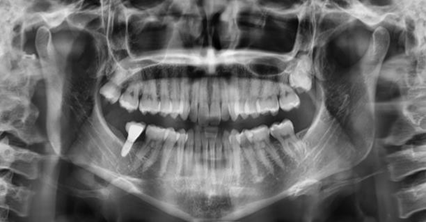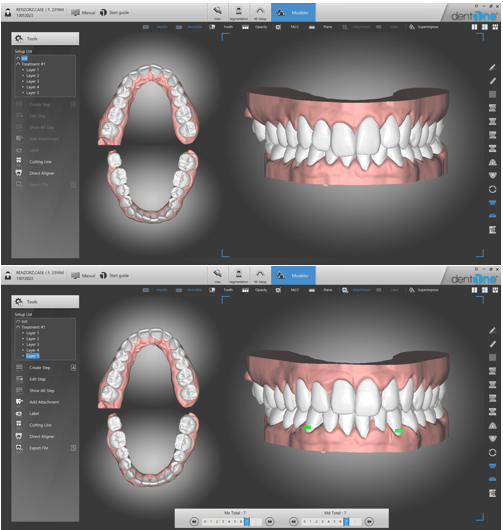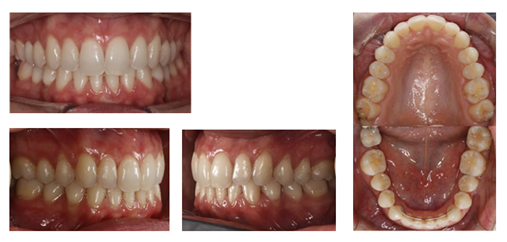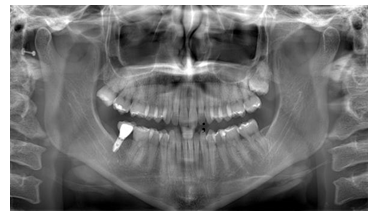Journal of
eISSN: 2373-4345


Case Report Volume 14 Issue 3
Master and Specialist in Orthodontics, Private Clinic in Ribeirão Preto, São Paulo, Brazil, BBO (Brazilian Board of Orthodontics) and President of ABOL (Brazilian Lingual Orthodontics Association) 2023–24
Correspondence: M.Sc Henrique Bacci, Faculty of Dentistry São Leopoldo Mandic, Av. Braz Olaia Acosta, 727, Sl 504, Jd Califórnia, Ribeirão Preto, São Paulo, Brazil
Received: July 05, 2023 | Published: July 20, 2023
Citation: Bacci H. Enhancing root torque correction in a clear aligners treatment. J Dent Health Oral Disord Ther. 2023;14(3):71-75. DOI: 10.15406/jdhodt.2023.14.00597
The correction of root torque is a crucial aspect of orthodontic treatments. With the growing popularity of clear aligners, there is a need to establish their effectiveness in controlling root torque. This study presents a case of retreatment in which root positioning correction was required for multiple teeth. The outcomes demonstrated that two sets of aligners, along with additional refinement, were necessary to achieve a favorable clinical outcome in terms of aesthetics and periodontal health. While the results were positive, it is recommended that further studies like this one be conducted to gather more evidence regarding the use of aligners for orthodontic root torque correction. Furthermore, pre-, and post-treatment tomographic examinations could provide more precise insights into the potential of aligners in correcting root torque.
Keywords: technology, dental aesthetics, clear aligners
Orthodontic treatment utilizing CAD-CAM technology has gained global support, and within this realm, Clear Aligners have expanded their scope of applications and amassed evidence for treating increasingly complex cases.1–3 This article aims to showcase the orthodontic treatment of a patient with Class I malocclusion using CAD-CAM-manufactured clear aligners. The patient's primary concern revolved around smile aesthetics. Additionally, the patient presented with a fragile periodontal condition characterized by gingival recessions affecting multiple teeth, along with clinically mispositioned roots in relation to the corresponding alveolar bone.
This article provides a comprehensive step-by-step discussion of the digital workflow involved in orthodontic treatment, with a specific focus on the utilization of pay-per-export software for digital planning by professionals, as well as the external production of appliances by a specialized company. The benefits of this digital approach, both in terms of clinical outcomes and financial advantages, are thoroughly explained. With the patient's remarkable level of cooperation, clear aligners were deemed the ideal orthodontic treatment modality, as further elaborated in the subsequent sections.
Patient R.S.Z., a 23-year-old female (Figures 1–8), presented at the clinic with a Class I malocclusion and expressed dissatisfaction with the alignment of her smile. Her main concern was the alignment of her lower anterior teeth, and she also expressed a desire for an increased smile width if possible. Upon clinical examination, it was observed that the patient had gingival recessions, particularly on the labial surface of the premolars, indicating a periodontal concern. The posterior segment of the lower teeth displayed a significant lingual inclination. Furthermore, all four canines exhibited lingual inclination in the crowns, necessitating root correction towards the interior to align them with the bundle bone and reduce the risk of gingival recession.

Figure 1-8 N=57; Epidemiological distribution of the pathological fractures, traumatic fractures, and nonunion.
During the clinical examination, black spaces were observed between the lower and upper central incisors. However, no other periodontal issues such as spontaneous blending or bleeding on probing were detected. The panoramic radiograph (Figure 9) revealed a general reduction in horizontal alveolar bone height, which was particularly noticeable in the lower anterior region. Additionally, a dental implant was noted in the area of tooth 47, and the third upper molars were present.

Figure 9 N=57; Epidemiological distribution of the pathological fractures, traumatic fractures, and nonunion.
Treatment goals
Treatment plan
The patient expressed a strong preference for clear aligners and declined the option of using any type of fixed braces. In this case, removable appliances, such as clear aligners, were considered a suitable option due to their hygiene advantages. The patient exhibited a high level of motivation to comply with the use of clear aligners. Following a discussion about the limitations of aligners, it was mutually agreed with the patient that aligners would be chosen to achieve the desired aesthetic correction. Furthermore, digital software tools could be employed to assess the feasibility of improving root placement during the treatment process.
Virtual planning
The STL files of the jaws were uploaded to a Virtual Planning Software for Aligners, specifically www.ezdentone.com, based in Seoul, Korea Republic. The virtual planning process was conducted in layers, starting with the expansion of the upper and lower arches.
The alignment of the upper and lower teeth was then progressively addressed. In the initial phase of the treatment, the focus was on achieving expansion, particularly with careful attention to the labial movement of the lower teeth. The reduction of overbite and regularization of the smile curve were also planned. Interproximal reduction was avoided, except for the area between the upper and lower incisors, to minimize the presence of black spaces. The treatment was divided into layers using a "4 by 4" staging approach, which involved producing aligners in pairs, resulting in four aligners per layer (Figure 10 & 11).4

Figure 10-11 N=57; Epidemiological distribution of the pathological fractures, traumatic fractures, and nonunion.
As the patient exhibited improved adaptation to the aligners (approximately 3 months into treatment, in the third layer), a virtual torque correction was initiated. Negative attachments were strategically applied at specific locations to assist in the torque correction mechanism (Figure 12).

Figure 12 N=57; Epidemiological distribution of the pathological fractures, traumatic fractures, and nonunion.
In the initial treatment phase, a series of 20 pairs of aligners were generated to advance the treatment.
An additional phase of aligners and a refinement were required for the final detailing of occlusion. The Table 1 above provides a general summary of the number of phases, layers, number of aligners, and additional resources utilized throughout the treatment.
|
Phase |
Layers |
Number of aligners |
Negative attachments |
|
1 |
5 |
20 |
Yes |
|
2 |
4 |
16 |
Yes |
|
Refinement |
1 |
4 |
No |
Table 1 General summary of the number of phases, layers, number of aligners
Out serviced aligners production
The files obtained from the virtual planning were utilized to produce the aligners using the Self Aligner virtual platform (https://self.ddo.dental/) provided by Aditek (Cravinhos, São Paulo, Brazil), specifically the YouPlan option. This platform allows orthodontists to personally engage in digital treatment planning while outsourcing the manufacturing process of the aligners.
The clinical results are depicted in intraoral Figures 13–17, which showcase the progress and outcome of the treatment. The treatment was successfully concluded with a total of 40 sets of aligners. Each aligner was worn for duration of 7 days, resulting in a total treatment time of approximately 10 months. This timeline demonstrates the commitment and dedication of both the patient and the dental team throughout the treatment process. Completing the treatment within the expected timeframe is a significant achievement and highlights the effectiveness of using clear aligners for orthodontic corrections.

Figure 13-17 N=57; Epidemiological distribution of the pathological fractures, traumatic fractures, and nonunion.
Additionally, a final panoramic X-ray (Figure 18) was taken to assess the overall alignment and positioning of the roots. The smile results (Figures 19 & 20) and torque changing details of the left canines can be observed in the Figures 21 & 22.

Figure 18 N=57; Epidemiological distribution of the pathological fractures, traumatic fractures, and nonunion.
Despite the increasing significance of clear aligners as a treatment modality, patient compliance continues to play a critical role in achieving the desired correction.5 The success of the treatment heavily relies on the patient's commitment to wearing the aligners as instructed and following the recommended treatment protocols. In cases where patient compliance is low, the duration of treatment may be prolonged, and the outcome of the orthodontic correction could be compromised.6
Indeed, in this specific case study, the patient had a strong aversion to wearing fixed braces again and readily embraced clear aligners as an alternative treatment option. Remarkably, the patient reported a higher quality of life with the use of clear aligners compared to previous experiences with braces treatments. This could be attributed to the increased comfort, convenience, and improved aesthetics offered by clear aligners, which align with the patient's personal preferences and lifestyle.7 The patient's positive experience emphasizes the importance of considering individual patient factors and preferences when selecting the most appropriate orthodontic treatment approach.
The increasing popularity of aligners can be attributed to several factors, with two notable ones being the reduced incidence of root damage8,9 and improved hygiene compared to fixed appliances.10,11 It is important to acknowledge the resources available today that have greatly facilitated the logistics of aligner fabrication and reduced costs. The widespread use of intraoral scanners and software that allows for free design (with a pay-per-export system) has made the process more accessible and efficient. These advancements have contributed to the overall growth and accessibility of aligner treatment, making it a preferred option for many patients and orthodontic practitioners alike.
Precise virtual setup planning plays a crucial role in achieving optimal results with aligners. Nowadays, orthodontists have a variety of options for digitally planning their cases. They can choose to submit their cases to external services for complete planning or invest in their own software for in-house planning. In this particular study, a free design software was utilized, which means that the orthodontist pays based on the number of file exports required. This allows for greater flexibility and cost control, enabling orthodontists to have more direct involvement in the treatment planning process while utilizing digital tools to enhance efficiency and accuracy.
There is indeed a recent trend in orthodontic practice where aligner production is outsourced. Orthodontists are partnering with specialized companies that handle the manufacturing process, allowing them to focus on treatment planning and patient care. The decision to delegate the production of aligners to an external company proved to be highly suitable in terms of convenience and cost reduction. By outsourcing the aligner production, the orthodontic practice was able to streamline their workflow and focus on digital treatment planning and patient care.
This approach offers several advantages, including access to the expertise and efficiency of dedicated aligner manufacturers. By utilizing this modality, orthodontists can maintain greater control over the treatment process while benefiting from the streamlined workflow and optimized treatment outcomes offered by aligner manufacturing companies. This integration of advanced digital platforms and outsourcing options highlights the ongoing integration of technology in orthodontic practice, ultimately benefiting both practitioners and patients alike.3
The presented study showcases the orthodontic retreatment of a patient who primarily expressed concerns about the aesthetics of their smile. Upon closer examination, the need for torque correction in multiple teeth was also identified. Initially, Class I malocclusions may be considered relatively straight forward for aligner treatment. However, the significant indication for torque correction in multiple teeth for this patient diminishes the predictability of aligner treatment alone.12–14 Nevertheless, the patient's motivation to comply with aligner usage played a vital role in the decision to proceed with this treatment modality.
Aligners have made remarkable progress in recent years; however, there are still certain types of tooth movements that pose challenges for the system. Predictable vestibule lingual movements can generally be achieved15 using aligners. However, rotation movements, especially involving canines and posterior teeth, are considered complex to be solely performed with aligners.16 Similarly, achieving intrusion of lower incisors and correcting root torque using aligners alone is considered challenging.15,17 These limitations should be considered when planning orthodontic treatment with aligners, and alternative approaches or adjunctive techniques may be necessary to address these specific tooth movements effectively.
The literature indicates that, on average, only around 50% of the predicted tooth movement in virtual setups is observed in actual practice among patients undergoing aligner treatment.17 Among the various types of movements, torque correction is considered one of the least predictable with aligners.15–17 This highlights the importance of carefully considering the limitations and potential challenges associated with torque correction when planning orthodontic treatment with aligners. Orthodontists should closely monitor the progress of torque correction during treatment and be prepared to adjust or consider alternative approaches if necessary to achieve the desired results.
In this study, the patient presented with specific requirements for different types of tooth movements, including rotation of upper incisors, intrusion of lower incisors, and rotation of lower premolars. The need for torque changes, particularly in the lower arch, was prominent. The patient's lower teeth exhibited excessive lingual inclination, and there were clinical indications of gingival recession, underscoring the importance of torque correction in multiple teeth. In cases like the one presented here, additional resources may be necessary, such as the production of extra aligners, incorporating over corrections, and utilizing negative attachments to optimize the treatment outcome. To enhance result evaluation, CT scans can offer valuable supplementary information for future scientific endeavors.18
Two virtual setup studies were conducted to generate the aligners, followed by an additional refinement set to finalize the treatment process. These steps demonstrate the comprehensive approach taken to address the specific orthodontic needs and challenges of the patient in this study.
In conclusion, the utilization of clear aligners proved to be an effective and patient-friendly alternative, considering the patient's motivation and preference for removable appliances. Despite the complexity of the required tooth movements, including torque correction and various rotations, the treatment outcomes were favorable, with improvements in both esthetics and periodontal health. Nonetheless, with advancements in technology and increased patient compliance, clear aligners continue to gain popularity as a viable orthodontic treatment option. Further research using CT scans and clinical studies are necessary to enhance the predictability and broaden the scope of tooth movements achievable with aligners.
None.
Dr. Bacci has held lectures and conferences for Aditek and dentOne in the past 5 years. The presented study was conducted without any support (financial or technical) from both, Aditek or dentOne.

©2023 Bacci. This is an open access article distributed under the terms of the, which permits unrestricted use, distribution, and build upon your work non-commercially.